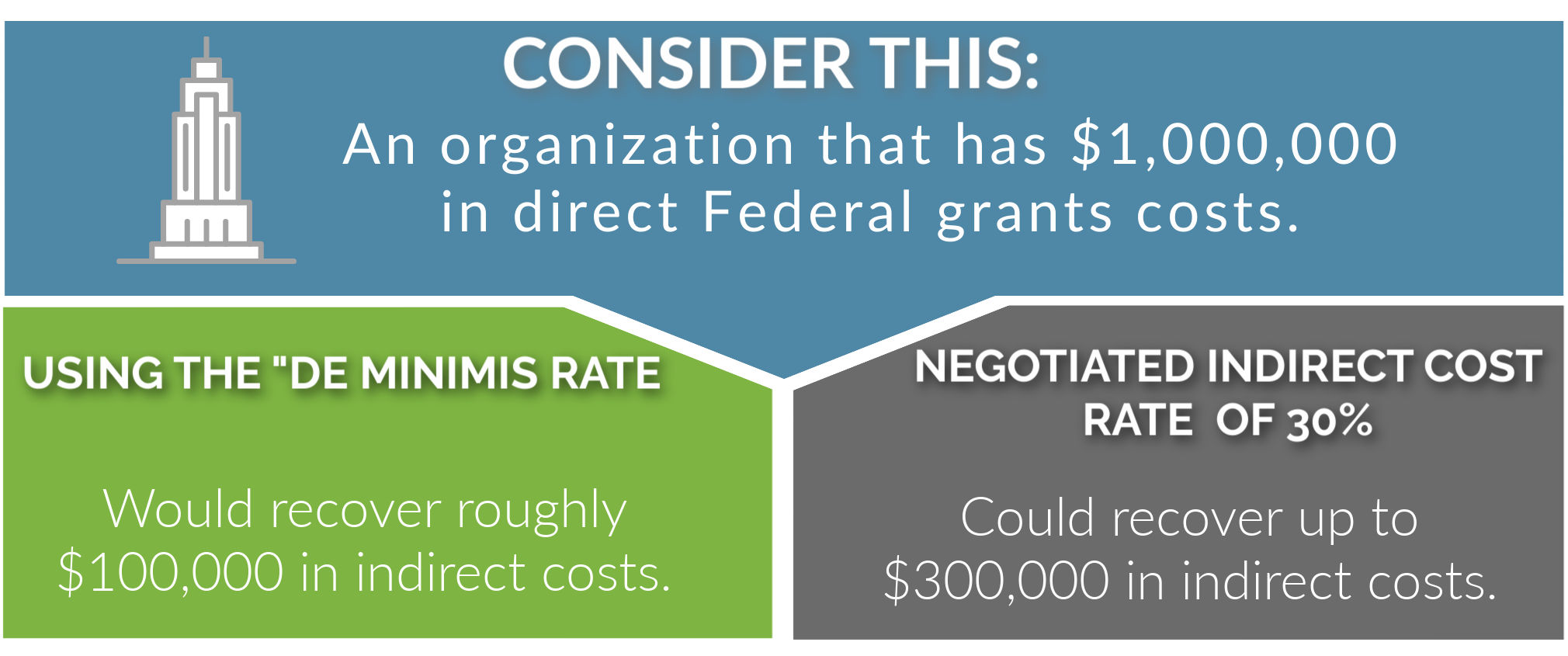Summary
Is your organization leaving money on the table that could be critical to your mission?
One of the major benefits afforded by the implementation of Uniform Guidance is the ability for Federal grantees to negotiate rates for indirect cost recovery. Unfortunately, many organizations still have not taken advantage of this benefit.
We invite you to read more and watch the video below with Dan Durst, Senior Manager from Capital Edge Consulting, as he provide valuable insight with 5 reasons grant recipients should NOT use the De Minimis Rate.
Assure you are “not leaving money on the table” by utilizing new opportunities to non-Federal entities that provide the right to Indirect Cost Recovery.
What is the De Minimis Rate?
The term “de minimis” characterizes something that may be too small or insignificant to be of significance. It is a derivative from the Latin phrase “de minimis non curat lex,” which translates to “…about minimal things.”
Uniform Guidance –Sweeping Changes Bring the Right, to Indirect Cost Recovery.
Uniform Guidance introduced sweeping changes to administrative requirements, cost principles, and audit requirements for Federal awards to non-Federal entities. These changes brought new responsibilities and opportunities to non-Federal entities. Unfortunately, most publicly available guidance focuses primarily on helping non-Federal entities cope with the added responsibilities, leaving little consideration to the new opportunities that are now available. The most overlooked of these opportunities is the ability, but more importantly the right to Indirect Cost Recovery.
Organizational Eligibility Overview:
- Non-federal organizations that never held a negotiated rate.
- State or Local Governments and Indian Tribes receiving over $35M in direct federal funding.
- Non-federal entities who currently have or previously had a negotiated indirect cost rate or approved cost allocation plan.
Did your Organization elect to charge a “de minimis” rate of 10% of modified total direct costs?
Prior to Uniform Guidance, the ability to apply for and be awarded a negotiated indirect cost rate agreement (NICRA) was heavily dependent on the Federal awarding agency. Since December of 2014, non- Federal entities have the option to submit an indirect cost rate proposal and negotiate a rate based on the prior year’s cost information. Additionally, a non- Federal entity that has never had a NICRA may elect to charge a “de minimis” rate of 10% of modified total direct costs (MTDC), but those organizations that elect to use the “de minimis” rate may be passing on the opportunity to recover significantly more indirect costs. Consider the meaning for the phrase “de minimis”: lacking significance or importance or so minor as to merit disregard.
Does the above definition characterize your organization's attitude toward recovering indirect costs?
Recovering Every Dollar on Federal Grants
Organizations owe it to their mission and to their stakeholders to take full advantage of and recover every dollar of funding that is available. By settling for the “de minimis” rate, an organization has accepted the Federal government’s self-serving offer and has done a disservice to its stakeholders. As budgets become tighter and meetings become more difficult due to reductions in funding, organizations may find relief by recovering more indirect costs on their Federal grants.

If your organization has never had a Federally negotiated indirect cost rate or if you have elected to use the “de minimis” rate, please provide us the opportunity to show you how much money you could be recovering for your organization. Capital Edge Consulting is actively working with Federal grantees all over the country to develop and negotiate Federal indirect cost rate agreements. Our industry experts will guide you through the calculation, proposal, and negotiation of de minimis indirect cost rates.
De Minimis Frequently asked Questions and Terms
For purposes of the 10% De minimis rate, indirect costs are costs incurred specifically for a common purpose and time consuming or costly to allocate to a specific cost objective.
These can include; office space rental, any associated utilities, and clerical and managerial staff salaries.
The meaning of de minimis cost means that the expenditure of county funds is so small as to be insignificant or negligible.
Have Questions or need Consulting
Expertise Regarding Federal Grants?
Capital Edge combines our team’s experience in consulting, public accounting, industry, and government to provide you with unmatched Federal Grants Compliance expertise. Our consultants provide government contractors and nonprofit organizations with a wide variety of services focused on overcoming their most difficult compliance challenges. We are committed to helping organizations overcome these challenges so that they can focus on what is most important, which is the successful implementation of their Federal award.



